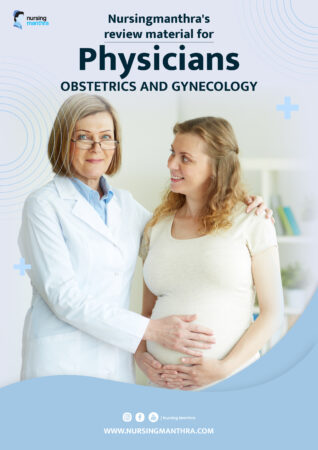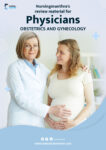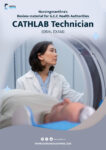1. A 9-week pregnant woman presents with abdominal pain and mild vaginal bleeding. On examination, the cervical os is closed. What is the next best step in management?
A. Immediate surgical evacuation
B. Start antibiotics
C. Assess for threatened miscarriage or ectopic pregnancy
D. Discharge home with no follow-up
Answer: C. Assess for threatened miscarriage or ectopic pregnancy
Rationale:
Closed cervical os with pain and bleeding suggests threatened miscarriage, but ectopic pregnancy must be ruled out. Assessment with ultrasound and β-hCG is essential for proper diagnosis and management.
2. A 9-week pregnant woman presents with mild vaginal bleeding and abdominal pain. On examination, the cervical os is closed, and transvaginal ultrasound confirms a live intrauterine pregnancy with fetal heartbeat. What is the best next step in management?
A. Administer progesterone and discharge the patient
B. Reassure the patient, advise rest, and schedule follow-up
C. Perform dilation and curettage (D&C)
D. Administer methotrexate
Answer: B. Reassure the patient, advise rest, and schedule follow-up
Rationale:
This is a case of threatened abortion. With a closed os and viable fetus, the best management is reassurance, pelvic rest, and follow-up. Other interventions like D&C or methotrexate are inappropriate.
3. A 9-week pregnant woman presents with mild vaginal bleeding and abdominal pain. On examination, the cervical os is open, and transvaginal ultrasound shows products of conception in the uterus but no fetal heartbeat. What is the best next step in management?
A. Expectant management with follow-up β-hCG
B. Administer progesterone and observe
C. Perform dilation and curettage (D&C)
D. Administer methotrexate
Answer: C. Perform dilation and curettage (D&C)
Rationale:
An open cervix with non-viable pregnancy indicates inevitable abortion. D&C is preferred to ensure complete evacuation and prevent complications like heavy bleeding or infection.
4. A 30-year-old woman at 9 weeks of gestation presents with mild abdominal pain and vaginal bleeding. Speculum examination shows a closed cervical os, and a transvaginal ultrasound confirms a live intrauterine pregnancy with a fetal heartbeat. What is the most likely diagnosis?
A. Threatened abortion
B. Inevitable abortion
C. Missed abortion
D. Ectopic pregnancy
Answer: A. Threatened abortion
Rationale:
Threatened abortion is defined by vaginal bleeding in early pregnancy with a closed cervical os and a live intrauterine pregnancy. The presence of fetal heartbeat confirms viability.
5. Which of the following findings is most consistent with the diagnosis of a threatened abortion?
A. Open cervical os with passage of tissue
B. Closed cervical os with a viable intrauterine pregnancy
C. Absence of fetal heartbeat on ultrasound
D. Gestational sac located outside the uterine cavity
Answer: B. Closed cervical os with a viable intrauterine pregnancy
Rationale:
Threatened abortion presents with vaginal bleeding and a closed cervix in the presence of a viable intrauterine pregnancy. Other options suggest inevitable abortion, missed abortion, or ectopic pregnancy.
6. Which of the following investigations is most important to confirm the diagnosis of threatened abortion?
A. Serum progesterone level
B. Quantitative β-hCG levels
C. Transvaginal ultrasound
D. Complete blood count (CBC)
Answer: C. Transvaginal ultrasound
Rationale:
Transvaginal ultrasound is the key investigation to confirm fetal viability and location of the pregnancy, helping to differentiate between threatened abortion and other conditions.
7. In a patient with Rh-negative blood type and vaginal bleeding in early pregnancy, what is the next step in management?
A. No specific intervention is required
B. Administer anti-D immunoglobulin
C. Administer progesterone supplements
D. Perform dilation and curettage
Answer: B. Administer anti-D immunoglobulin
Rationale:
Rh-negative women with any bleeding during pregnancy should receive anti-D immunoglobulin to prevent Rh alloimmunization, which can affect future pregnancies.
8. What percentage of threatened abortions typically progress to a viable pregnancy?
A. 10%
B. 25%
C. 50%
D. 70%
Answer: C. 50%
Rationale:
About 50% of pregnancies with first-trimester bleeding and closed cervical os result in a continued viable pregnancy.
9. Which of the following is an appropriate recommendation for a patient with a threatened abortion?
A. Immediate surgical management
B. Bed rest and pelvic rest
C. Initiate broad-spectrum antibiotics
D. Discontinue all medications, including prenatal vitamins
Answer: B. Bed rest and pelvic rest
Rationale:
In threatened abortion, conservative management with rest and avoidance of strenuous activity is recommended to reduce the risk of progression to miscarriage.
10. What is the most common cause of vaginal bleeding in the first trimester?
A. Ectopic pregnancy
B. Threatened abortion
C. Gestational trophoblastic disease
D. Placenta previa
Answer: B. Threatened abortion
Rationale:
Threatened abortion is the most frequent cause of first-trimester vaginal bleeding in pregnant women.
11. Which of the following is NOT a risk factor for threatened abortion?
A. Advanced maternal age
B. Previous history of miscarriage
C. Low maternal BMI
D. Use of prenatal vitamins
Answer: D. Use of prenatal vitamins
Rationale:
Prenatal vitamins support a healthy pregnancy and are not a risk factor for threatened abortion. Advanced age and history of miscarriage are known risk factors.
12. When should follow-up be arranged after an initial evaluation of a threatened abortion?
A. No follow-up is needed if symptoms improve
B. Within 48–72 hours with repeat β-hCG or ultrasound if symptoms persist
C. Only after the second trimester begins
D. Immediately after hospital discharge
Answer: B. Within 48–72 hours with repeat β-hCG or ultrasound if symptoms persist
Rationale:
If symptoms continue, follow-up within 48–72 hours with β-hCG and ultrasound helps assess viability and rule out complications like ectopic pregnancy or miscarriage.
13. A 39-week pregnant woman presents in labor. On per vaginal examination, the nose and mouth are palpable. What is the most appropriate mode of delivery?
A. Normal vaginal delivery
B. Assisted vaginal delivery with forceps
C. Cesarean section
D. External cephalic version followed by vaginal delivery
Answer: C. Cesarean section
Rationale:
Face presentation with palpable nose and mouth, especially if mentum posterior, is best managed with cesarean section due to risks associated with vaginal delivery in this malpresentation.
14. A 28-year-old woman presents with irregular vaginal bleeding two months after molar pregnancy evacuation. Serum β-hCG levels are persistently elevated, and ultrasound shows hypervascular uterine lesions. Chest X-ray reveals multiple nodular shadows. What is the best initial management?
A. Surgical evacuation of the uterus
B. Methotrexate-based chemotherapy
C. Total abdominal hysterectomy
D. Observation with weekly β-hCG monitoring
Answer: B. Methotrexate-based chemotherapy
Rationale:
Choriocarcinoma is a malignant GTD with high β-hCG and lung metastasis. First-line treatment is chemotherapy, which is highly effective even in metastatic cases.
15. A 3-year-old child presents with fever, conjunctival erythema, and a rash in the mouth. What is the most likely diagnosis?
A. Measles
B. Rubella
C. Respiratory Syncytial Virus (RSV) infection
D. Hand, Foot, and Mouth Disease
Answer: A. Measles
Rationale:
Measles presents with fever, conjunctivitis, cough, coryza, and Koplik spots in the mouth. The rash typically starts on the face and spreads downward.





















